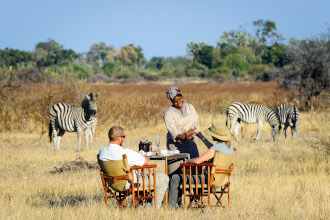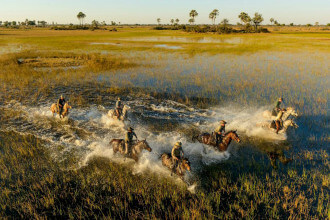Desert Rhino Camp - The Details
Desert Rhino Camp lies amongst rolling, rocky hills with scattered euphorbia, ancient welwitschia plants, scrubby vegetation and isolated clumps of trees of the 450 000-hectare Palmwag Concession. This region is marked for its tranquil, minimalist beauty, surprising wealth of arid-adapted wildlife and the largest free roaming black rhino population in Africa.
Desert Rhino Camp functions as a collaborative effort between Wilderness
Safaris and the Save the Rhino Trust (SRT) - an NGO that has been has been instrumental in the preservation of these rare, desert adapted black rhino. Having barely survived the slaughter of '80s and '90s throughout other parts of Africa, the black rhino population has doubled since the formation of the SRT.
Set in a wide valley sometimes flush with grass, accommodation at Desert Rhino Camp is in the form of 8 Meru-style canvas tents that sleep up to 16 guests. Raised from the ground on a wooden deck, each tent features an en-suite bathroom with a hand basin, flush toilet and shower. Beds are made up with crisp, white linen and have two dark wood bedside tables with wicker reading lamps. An extension of the deck functions as a front verandah where guests can relax in director's chairs to take in the magnificent vistas of the surrounding desert and Etendeka Mountains. Extra duvets are available for the sometimes frosty nights.
The tented restaurant and lounge area of Desert Rhino Camp is also raised on a wooden deck in a single tent which is open plan and has partially open sides offering panoramic views. To one side there are couches and to the other a large, simple dining table. Evening meals are taken around the fire pit, in front of the lapa, where guests can relax and socialize.
Activities at Desert Rhino Camp obviously include rhino tracking on foot or by vehicle. Other 4x4 outings are geared at exploring this vast, miraculous ecosystem with some of the most knowledgeable guides in Namibia.
Palmwag Concession's freshwater springs also support healthy populations of desert-adapted elephant, Hartmann's mountain zebra, giraffe, gemsbok, springbok, kudu and predators such as lion, cheetah, leopard, brown and spotted hyaena. Bird life is prolific and diverse with most of Namibia's endemics present.
 2023 Guest Reviews
2023 Guest Reviews
 Kruger Walking Safari
Kruger Walking Safari
 Botswana Trip Report
Botswana Trip Report




















